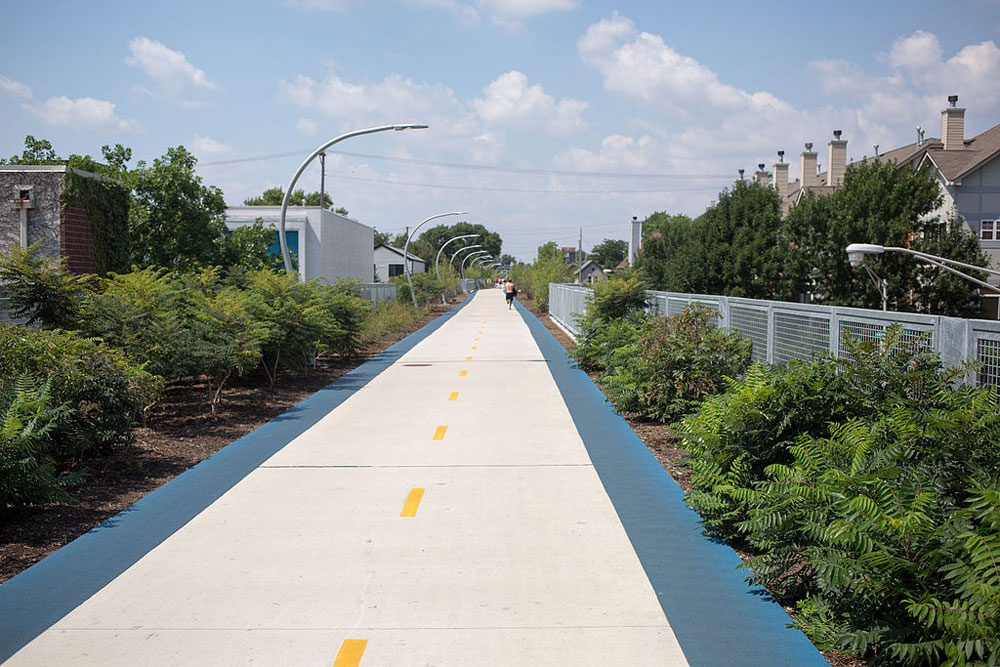
January 30, 2019; Chicago Reporter
In recent years, some of the most popular attractions of urban settings are the unusual green spaces that have been developed. If you ask what to see in New York, you will often be told not to miss a walk on the High Line. And in Chicago, that special green space is the 606 Trail, a source of great pride for many, but also a source of great economic angst for those who live nearby and have modest incomes.
The 606 is a special park. Built on 2.7 miles of elevated railroad tracks, it runs through four Chicago neighborhoods. Since its 2015 opening, it’s been a wonderful place to walk, bike, play, and gain an elevated perspective of the area and take some great shortcuts to local haunts. But the neighborhoods around the 606 have changed, and so have the neighbors. Property values have skyrocketed, and the areas have gentrified, with developers buying up affordable housing and rebuilding it for wealthier tenants. The claims on the website of the 606 of creating “a park and trail system that would connect four Chicago neighborhoods and create innovative park space that would serve both residents and visitors” may ring hollow for displaced residents of those communities.
Recently, in a move to stem the rampant gentrification of areas around the 606, the aldermen from those communities won a six-month freeze on demolition permits. They hope to use the time to develop strategies to reduce the displacement of longtime, and particularly moderate- and low-income, residents from the communities.
One strategy being pursued is the use of community land trusts. For instance, a new community land trust called Here to Stay projects that with $2 million over three years, it could acquire, fix up, and sell 20 small properties, providing affordable housing to 50 homeowner and renter families. This is one of a few community land trusts in development in Chicago, along with the Chicagoland Owners Land Trust in southwest Chicago, as well as two more efforts in the Northwest Side and East Garfield Park.
Sign up for our free newsletters
Subscribe to NPQ's newsletters to have our top stories delivered directly to your inbox.
By signing up, you agree to our privacy policy and terms of use, and to receive messages from NPQ and our partners.
Still residents bordering the 606 question whether this is too little and too late. A report by the Urban Institute discussed the issue of “green gentrification,” where public investment in green spaces, such as the 606 or New York’s High Line, raises property values and push existing residents out. “Recent research finds,” according to the report, “that by potentially denying access to park amenities, green gentrification can perpetuate poverty and reduce health benefits for low-income neighborhoods and communities of color.”
It is clear from this that communities need to be proactive if they want to maintain diversity in neighborhoods they are seeking to improve with the building of innovative green spaces. Chicago, despite promises to the contrary from then-mayor Rahm Emanuel, was much more motivated by politics and tax revenues that would be generated by the gentrified properties around the 606. Higher property taxes in the area were among the motivating factors for many of the moderate-income property owners to sell to developers, who then turned their properties into luxury condos and homes along the 606. Christian Diaz, lead housing organizer at the Logan Square Neighborhood Association, raised the issue of whether amenities like the 606 “should be available to all Chicagoans or just to the very wealthy.” The association is now looking into conducting a racial equity analysis of the 606 to help develop a more comprehensive strategy.
There are some things afoot beyond the freeze on demolition permits. Increasing demolition fees is among them. Looking into property tax relief seems to be in order in these communities, particularly for those with the least means. The city inspectors seem to have an alliance with the developers, which does not work in favor of low-income homeowners, who seem receive numerous citations from inspectors resulting in costly repairs that they cannot afford. That needs to be addressed by the city. Organizations within the communities have begun to rally to these issues, but the core issue will be one of political will. In Chicago, that is always a weighty issue.
And there is now another area to watch. As plans for the Obama Presidential Library develop, with its location on Chicago’s South Side, the issue of gentrification of that area looms large. This will be a challenge, not unlike the 606, and one that newly installed Mayor Lori Lightfoot has made an effort to address. NPQ has written about this, but what has been presented seems to be the “light” version of how to intervene in gentrification. All indications are that it may not be enough, and that, again, it may be too little and too late.
If you visit Chicago, do put a walk or bike ride on the 606 on your “to do” list. And as you look over the sides at the lovely homes and condos, do think about who else might have lived there, and if others might also be enjoying this amenity of the city as a part of their neighborhood had the planning been more class- and race-conscious and equitable.—Carole Levine











